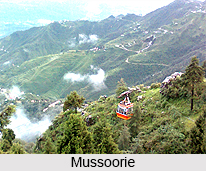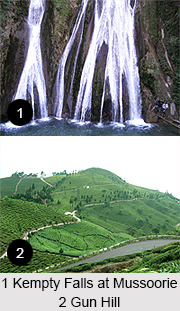 Mussoorie is a hill station in the Dehradun District of the northern Indian state of Uttarakhand. This hill station, situated in the foothills of the Garhwal Himalayan ranges, is also known as the "Queen of the Hills". It has an average altitude of 1,880 metres (6,170 ft). Mussoorie, with its green hills and varied flora and fauna, is a fascinating hill resort. Commanding snow ranges to the north-east and glittering views of the Doon Valley and Shiwalik ranges in the south, the town was once said to present a fairyland atmosphere to tourists.
Mussoorie is a hill station in the Dehradun District of the northern Indian state of Uttarakhand. This hill station, situated in the foothills of the Garhwal Himalayan ranges, is also known as the "Queen of the Hills". It has an average altitude of 1,880 metres (6,170 ft). Mussoorie, with its green hills and varied flora and fauna, is a fascinating hill resort. Commanding snow ranges to the north-east and glittering views of the Doon Valley and Shiwalik ranges in the south, the town was once said to present a fairyland atmosphere to tourists.
Etymology of Mussoorie
Mussoorie derives its name from the plants of "Mussoorie" or shrub "Mansoor" which are available in large quantities in this region.
History of Mussoorie
The history of Mussoorie dates back to 1825 when a shooting lodge was constructed jointly by Captain Young, an adventurous British military officer and Mr. Shore, the Superintendent of Revenues at Dehradun.
Places to Visit at Mussoorie
Mussoorie has several interesting tourist places like;
•Nag Devta Temple: An ancient temple dedicated to Lord Shiva and is situated on Cart Mackenzie Road about 6 km from Mussoorie on the way to Dehradun. This place provides an enthralling view of Mussoorie and the Doon Valley.
•Mussoorie Lake: Mussoorie Lake is a newly developed picnic spot located on Mussoorie-Dehradun road and is about 6 km from Mussoorie. It is a charming spot. It provides a captivating view of Doon valley and nearby villages.
•Gun Hill: The Gun hill is 2,143 metres above sea level and 400 metres away from the town. In the earlier days, a gun used to be fired from this hill at exactly 12 O"clock noon to indicate the time. Though the practice is discontinued and the gun removed, the spirit of the name hangs to the hill.
•Mossy Falls: Mossy Falls are located 7 km from town. Mossy Falls is one of the most illustrative picnic spots encircled by dense forest.
•Benog Hill: Benog Hill is located at an altitude of 2,104 metres. Once it was home of an observatory.
•Jwalaji Temple: Jwalaji Temple is situated on the top of the Benog Hill and has an idol of Mata Durga in it. The temple is surrounded by thick forest and offers picturesque view of the Himalayan peaks, Doon valley and Yamuna valley.
•Bhatta Falls: Bhatta Falls are situated on the Mussoorie-Dehradun road near the Bhatta checking post. Bhatta Falls are ideal for picnics.
•Kempty Falls: Kempty falls are located 12km away on the Mussoorie-Chakrata road and are the most beautiful spot in Mussoorie, attracting hundreds of people every day.
•Bhadraj Temple: Bhadraj Temple is located 15 km from Mussoorie. This temple is dedicated to Lord Sal Bhadra, brother of Lord Krishna. Bhadraj offers a captivating view of the Doon valley.
•Vinog Mountain Quail Sanctuary: Vinog Mountain Quail Sanctuary was established in 1993 covering an area of 339 hectares. This sanctuary has turned old now. It is famous for the vanished bird species, Mountain Quail, which was last spotted in 1876.
Best Time to Visit Mussoorie
Best season to go Mussoorie is from March to June and September to November. Summers are the best times to have trekking, rock climbing and camping.
How to Reach Mussoorie
The nearest railway station is Dehradun and the nearest airport is Jolly Grant in Dehradun. Mussoorie is conveniently connected by road to Delhi and major cities. It is called the "Gateway" to Yamunotri and Gangotri Shrines of Northern India. Taxis are easily available for Mussoorie as are buses at regular intervals.



















